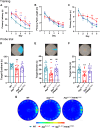Protective effect of PDE4B subtype-specific inhibition in an App knock-in mouse model for Alzheimer's disease
- PMID: 38521860
- PMCID: PMC11319650
- DOI: 10.1038/s41386-024-01852-z
Protective effect of PDE4B subtype-specific inhibition in an App knock-in mouse model for Alzheimer's disease
Abstract
Meta-analysis of genome-wide association study data has implicated PDE4B in the pathogenesis of Alzheimer's disease (AD), the leading cause of senile dementia. PDE4B encodes one of four subtypes of cyclic adenosine monophosphate (cAMP)-specific phosphodiesterase-4 (PDE4A-D). To interrogate the involvement of PDE4B in the manifestation of AD-related phenotypes, the effects of a hypomorphic mutation (Pde4bY358C) that decreases PDE4B's cAMP hydrolytic activity were evaluated in the AppNL-G-F knock-in mouse model of AD using the Barnes maze test of spatial memory, 14C-2-deoxyglucose autoradiography, thioflavin-S staining of β-amyloid (Aβ) plaques, and inflammatory marker assay and transcriptomic analysis (RNA sequencing) of cerebral cortical tissue. At 12 months of age, AppNL-G-F mice exhibited spatial memory and brain metabolism deficits, which were prevented by the hypomorphic PDE4B in AppNL-G-F/Pde4bY358C mice, without a decrease in Aβ plaque burden. RNA sequencing revealed that, among the 531 transcripts differentially expressed in AppNL-G-F versus wild-type mice, only 13 transcripts from four genes - Ide, Btaf1, Padi2, and C1qb - were differentially expressed in AppNL-G-F/Pde4bY358C versus AppNL-G-F mice, identifying their potential involvement in the protective effect of hypomorphic PDE4B. Our data demonstrate that spatial memory and cerebral glucose metabolism deficits exhibited by 12-month-old AppNL-G-F mice are prevented by targeted inhibition of PDE4B. To our knowledge, this is the first demonstration of a protective effect of PDE4B subtype-specific inhibition in a preclinical model of AD. It thus identifies PDE4B as a key regulator of disease manifestation in the AppNL-G-F model and a promising therapeutic target for AD.
© 2024. The Author(s).
Conflict of interest statement
The authors declare no competing interests.
Figures





References
MeSH terms
Substances
Grants and funding
- 2219 International Postdoctoral Research Fellowship/Türkiye Bilimsel ve Teknolojik Araştirma Kurumu (Scientific and Technological Research Council of Turkey)
- RPGF1806\76/Dunhill Medical Trust (DMT)
- BB/R019401/1/RCUK | Biotechnology and Biological Sciences Research Council (BBSRC)
- small pump priming grant/Alzheimer's Research UK (ARUK)
LinkOut - more resources
Full Text Sources
Medical
Molecular Biology Databases
Miscellaneous

